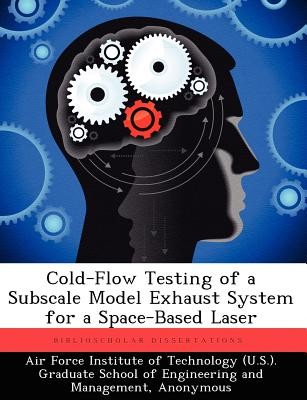
- We will send in 10–14 business days.
- Author: Ian S Bautista
- Publisher: BiblioScholar
- ISBN-10: 124944926X
- ISBN-13: 9781249449263
- Format: 18.9 x 24.6 x 0.6 cm, softcover
- Language: English
- SAVE -10% with code: EXTRA
Cold-Flow Testing of a Subscale Model Exhaust System for a Space-Based Laser (e-book) (used book) | bookbook.eu
Reviews
Description
The purpose of this research was to continue a study of gas-dynamic phenomena that occurred in stacked cylindrical rings of nozzles and an exhaust manifold as reported by Captain Scott Bergren in 2002. The rings and exhaust manifold were part of a 1/5- scale model of one quadrant of the conceptual Space Based Laser Integrated Flight Experiment (SBL IFX) gas dynamic laser. This model was mated to a blowdown/ vacuum wind tunnel and consisted of a nozzle array, centerbody, supersonic diffuser, and a transition structure to mate the vacuum and test section. During Capt Bergren's research, supersonic flow was found to only last for 0.2 seconds from wind tunnel startup. The short duration of the supersonic flow was due to the transition structure being too small and not being able to "swallow" the shock wave. The objectives of this research were to remodel the transition structure and evaluate the test section to see if simulation of the expected fluid flow properties in the conceptual SBL IFX design was possible using cold-flow. The transition structure was remodeled to capture the entire vacuum line entrance area while still mating to the diffuser exit. Using rapid data acquisition and schlieren photography, results indicated that supersonic flow lasted for approximately 10 seconds from startup. During this time, a well-defined oblique shock wave inside the optical cavity attached to the leading edge of the centerbody, where the flow reached a velocity of Mach 2.8.
EXTRA 10 % discount with code: EXTRA
The promotion ends in 17d.11:11:34
The discount code is valid when purchasing from 10 €. Discounts do not stack.
- Author: Ian S Bautista
- Publisher: BiblioScholar
- ISBN-10: 124944926X
- ISBN-13: 9781249449263
- Format: 18.9 x 24.6 x 0.6 cm, softcover
- Language: English English
The purpose of this research was to continue a study of gas-dynamic phenomena that occurred in stacked cylindrical rings of nozzles and an exhaust manifold as reported by Captain Scott Bergren in 2002. The rings and exhaust manifold were part of a 1/5- scale model of one quadrant of the conceptual Space Based Laser Integrated Flight Experiment (SBL IFX) gas dynamic laser. This model was mated to a blowdown/ vacuum wind tunnel and consisted of a nozzle array, centerbody, supersonic diffuser, and a transition structure to mate the vacuum and test section. During Capt Bergren's research, supersonic flow was found to only last for 0.2 seconds from wind tunnel startup. The short duration of the supersonic flow was due to the transition structure being too small and not being able to "swallow" the shock wave. The objectives of this research were to remodel the transition structure and evaluate the test section to see if simulation of the expected fluid flow properties in the conceptual SBL IFX design was possible using cold-flow. The transition structure was remodeled to capture the entire vacuum line entrance area while still mating to the diffuser exit. Using rapid data acquisition and schlieren photography, results indicated that supersonic flow lasted for approximately 10 seconds from startup. During this time, a well-defined oblique shock wave inside the optical cavity attached to the leading edge of the centerbody, where the flow reached a velocity of Mach 2.8.


Reviews